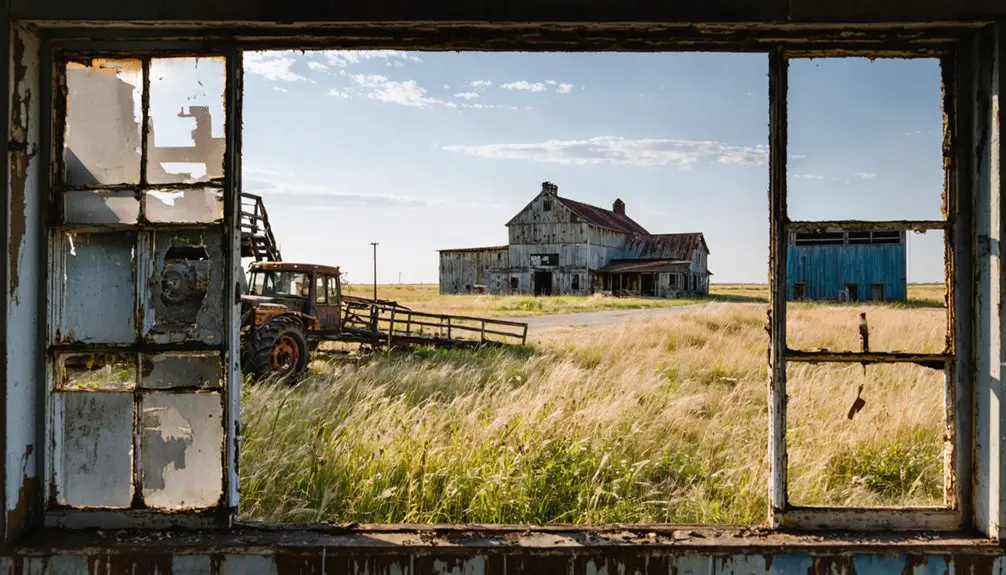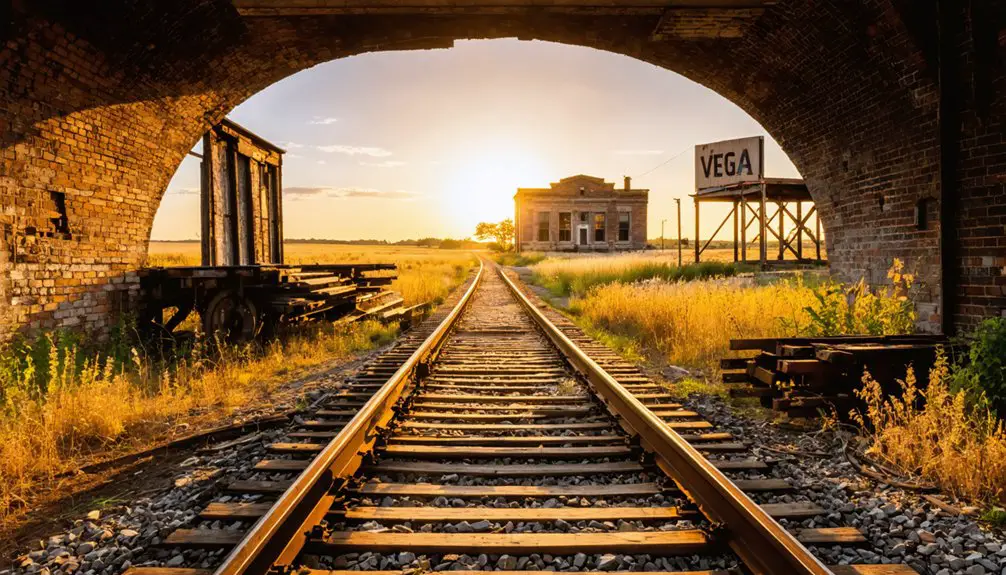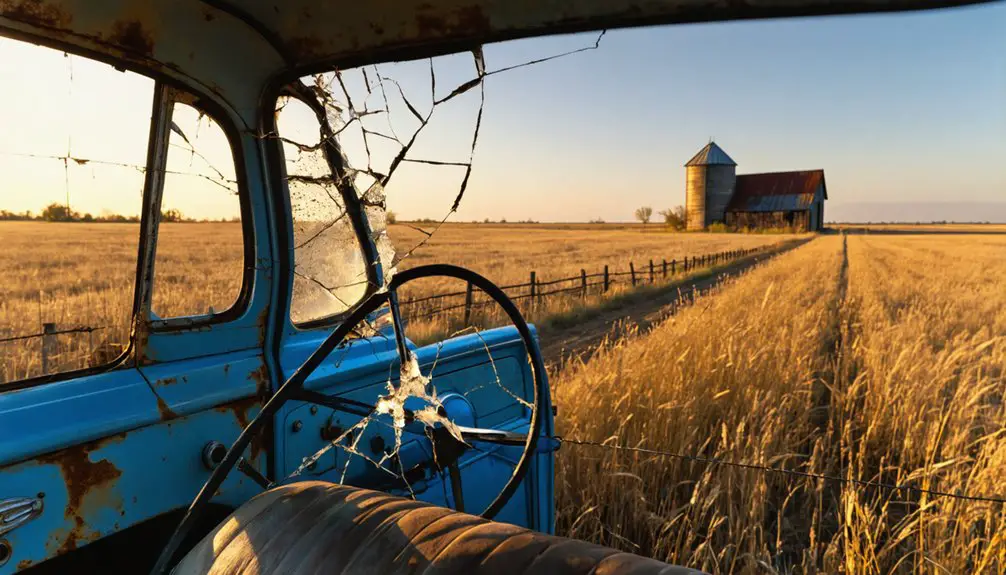You’ll find Vega’s remnants in Cherokee County, Kansas, where it boomed in the late 1800s as a mining settlement. The town thrived on rich lead, zinc, and coal deposits, reaching depths of 75 feet across 30 mines during its 76-year run. While railroad connections initially fueled growth, their eventual loss combined with depleted minerals led to Vega’s downfall. Today, prairie grasses cover what was once a bustling frontier community – and there’s quite a tale beneath those waves of green.
Key Takeaways
- Vega emerged as a boomtown in Cherokee County, Kansas during the late 19th century, driven by lucrative lead and zinc mining operations.
- Over 30 mines operated in Vega within 76 years, reaching depths of 25-75 feet after coal’s discovery by Heim Nelson in 1869.
- The town’s decline resulted from depleted coal deposits and lost railroad connections, following a typical boom-and-bust pattern of mining communities.
- Essential institutions like schools, stores, and post offices developed during Vega’s peak, supporting miners, merchants, and railroad workers.
- The former townsite has returned to prairie grassland, joining over 6,000 other documented “dead towns” in Kansas history.
Origins and Early Settlement
As mining operations expanded across the Tri-State Mining District in the late 19th century, Vega emerged as one of several boomtowns in Cherokee County, Kansas.
Following settlement patterns similar to nearby Galena and Empire City, Vega’s location was strategically chosen for its proximity to rich lead and zinc deposits that promised economic prosperity.
You’ll find Vega’s early development followed the typical mining boom trajectory, with mining companies quickly purchasing land and establishing essential infrastructure.
The town’s first residents included a diverse mix of immigrant laborers and their families, who built homes, saloons, and gambling halls.
While the exact founding date isn’t recorded, Vega’s establishment coincided with the region’s rapid industrial growth of the 1870s and 1880s, marking it as another ambitious venture in the district’s mineral rush.
Like Empire City, which reached 3,000 residents in its first year, Vega experienced rapid population growth as workers flocked to the area seeking mining opportunities.
The region would eventually become part of the Tar Creek Superfund site, highlighting the long-term environmental consequences of extensive mining operations.
Life Along the Railroad
When the railroad arrived in Vega during the late 19th century, it transformed the mining town into a vital transportation hub for Cherokee County.
You’d find railroad workers bustling around the tracks, while merchants and farmers gathered to ship their goods via the new freight transportation system. The town quickly developed essential institutions – a school that doubled as a meeting hall, stores, and a post office to serve the growing community.
Commerce blossomed as railroad workers, merchants and farmers converged at the tracks, while vital community services emerged to support Vega’s growth.
Life wasn’t always easy along the rails. You’d have witnessed trains requiring armed guards against attacks, and crews battling extreme weather conditions. The first settlers arrived in 1899, marking the beginning of steady development in the area.
But the railroad’s presence meant you could travel faster than ever before, and your agricultural products could reach distant markets. The rail line connected you to a broader network, making Vega an integral part of Kansas’s economic landscape. The rapid expansion of railroads led to immense population growth as Kansas reached nearly one million residents by 1880.
Geographic Significance
The strategic location of Vega, Kansas near the Oklahoma border shaped its destiny as more than just a railroad stop.
You’ll find this tiny 0.1-square-mile town nestled in the heart of the historic Tri-State Mining District, where it played an essential role in the region’s lead and zinc mining legacy. Like many entries in disambiguation pages, Vega shares its name with several other abandoned mining towns across America.
At 840 feet above sea level, Vega’s position along U.S. Route 69 made it easily accessible to neighboring communities like Picher, Oklahoma. The area witnessed significant unrest during the Bleeding Kansas era.
However, this prime location within the mining district ultimately led to its downfall. The environmental challenges from extensive lead contamination forced the town’s abandonment by 2012.
Today, while the buildings have been demolished to address health hazards, Vega’s geographic significance remains evident in the transformed landscape that tells the story of southeastern Kansas’s mining era.
The Prairie Community
You’ll find the prairie community of Vega exemplified the quintessential American frontier experience, where settlers carved out homesteads across the open plains and cultivated the rich soil for farming.
Similar to how Prairie School’s legacy influenced nearby communities, Vega’s educational facilities played a vital role in establishing the town’s identity and cultural foundation.
The town’s strategic position as a railroad stop made it a crucial hub for grain shipments and agricultural commerce, connecting local farmers to broader markets.
The settlement patterns followed the typical grid system, with farmsteads spread out along section lines and the town center anchored by the railroad depot, creating a community structure that was common throughout Kansas during the settlement period.
Residents organized various recreation programs and activities, much like modern communities today, to foster social connections and maintain a vibrant town life.
Life on Open Plains
Life in prairie communities during the late 19th century centered around essential institutions that formed the backbone of settler society. You’d find these institutions serving multiple purposes, with schools doubling as meeting halls and Masonic Lodges, while saloons acted as social hubs where you could catch up on local news.
- Schools, churches, and fraternal organizations emerged quickly, creating strong community bonds on the open plains.
- Social gatherings revolved around seasonal events and communal spaces, especially in towns that served as transport hubs.
- Prairie life involved shared hardships, from grasshopper plagues to tornadoes, fostering a spirit of mutual support.
Similar to how Lamont maintained its community through active churches, these gathering places helped preserve local connections. Towns like these experienced significant population changes over time, with many seeing peak numbers of 15,000 residents in the 1920s before declining sharply in subsequent decades. Despite environmental challenges, you could purchase land for as little as $1.00 per acre, though you’d often wait decades after initial land availability to establish your homestead.
Railroad Stop Culture
Railroad stops transformed prairie communities into vibrant social and economic hubs during the late 19th century, with companies strategically selecting flat terrain for their routes and stations.
You’d find the heart of railroad culture centered around multi-purpose buildings where schools shared space with Masonic lodges, and saloons served as informal community gathering spots. Local businesses thrived as these stops became vital transfer points for livestock, agricultural goods, and commercial products.
The railroad brought immediate development to these prairie settlements, with essential services like post offices and general stores springing up alongside the tracks.
You’d see how community gatherings revolved around train schedules, while hotels and diners catered to passengers and railroad workers alike, creating a distinctive social fabric that defined these growing prairie towns.
Agricultural Settlement Patterns
When pioneering settlers claimed their homesteads across the Kansas prairie in the late 1800s, distinct agricultural communities emerged through waves of European immigration.
Settlement patterns centered around immigrant groups like the Volga Germans and Mennonites, who brought crucial farming knowledge and cultural traditions to the region.
You’ll find these early prairie communities were marked by:
- Extensive wheat cultivation using specialized grains like Turkey Red wheat
- Diversified farming with crops including peas, alfalfa, and barley
- Development of essential infrastructure like grain elevators and cooperatives
Your ancestors’ agricultural diversity helped stabilize both the soil and local economies.
As farmsteads expanded, they formed the backbone of rural communities, complete with schools, churches, and stores – though many would later struggle during the harsh Dust Bowl years of the 1930s.
Rise and Decline Timeline
The discovery of coal by Heim Nelson in 1869 sparked Vega’s rapid transformation from untamed prairie to bustling mining settlement.
Like a strike of lightning on dry prairie, Nelson’s 1869 coal discovery transformed Vega into a booming frontier town.
You’ll find mining heritage woven throughout Vega’s story, as over 30 mines dotted the landscape within 76 years, reaching depths of 25 to 75 feet. The town’s infrastructure quickly expanded with stores, schools, and churches serving both miners and owners.
Like many ghost town legends of Kansas, Vega followed a familiar boom-and-bust pattern.
You’d have seen miners living in dugouts while owners built stone houses, with baseball games and band performances bringing the community together.
By the early 1900s, depleted coal deposits and lack of railroad connections sealed Vega’s fate.
The town’s remaining structures deteriorated as residents moved away, leaving behind empty buildings and abandoned dreams.
Economic Forces at Work

Several powerful economic forces shaped Vega’s ultimate decline, beginning with its heavy reliance on a single industry. The town’s economic dependency on limestone quarrying left it vulnerable when market conditions changed, while agricultural mechanization reduced the need for farm labor.
You’ll recognize familiar patterns that plagued many Kansas towns during this era:
- Railroad changes devastated local commerce, as shifts in rail routes and reduced traffic severed crucial transportation links.
- Farm consolidation meant fewer families could sustain local businesses, triggering waves of rural migration to urban centers.
- The loss of essential services – from grocery stores to schools – created a downward spiral that proved impossible to reverse.
Without economic diversification or new industries to replace the declining quarry operations, Vega couldn’t maintain its population or commercial significance.
Daily Life and Social Structure
During its peak years, Vega’s social fabric wove together diverse threads of daily life, from bustling mining shifts to vibrant community gatherings.
You’d find men working the mines while women ran boarding houses and local stores, creating a dynamic community rhythm. Social dynamics revolved around essential institutions like churches, schools, and saloons, where residents gathered to socialize and conduct business.
Community events often aligned with mining schedules and agricultural seasons, bringing together the town’s diverse population. You’d see a mix of permanent settlers and transient workers mingling at local establishments, while social institutions helped maintain order and cohesion.
The town’s layout centered around practical needs, with homes clustered near mines and key community buildings, fostering the close-knit atmosphere typical of early 20th-century Kansas towns.
Transportation Hub Legacy

You’ll find Vega’s transportation heritage deeply rooted in the arrival of the Choctaw, Oklahoma, and Texas Railroad in 1903, which established the town as a crucial shipping point for livestock and agricultural products.
Much like nearby Kansas towns such as Kanona, Vega’s commercial growth stemmed from its position along the railroad, with businesses like general stores and livestock facilities emerging to serve both rail workers and travelers.
The later addition of Route 66 through the area created a dual transportation corridor that temporarily sustained the town’s economy, even as railroad service began to decline.
Railroad Commerce Impact
As railroads expanded across Kansas in the late 1800s, Vega’s position within the growing network markedly influenced its early development and eventual decline. The railroad expansion brought crucial commerce opportunities through freight influence, much like other small Kansas towns that depended on rail connections for survival.
- Rail depots served as economic lifelines, allowing local businesses to ship and receive goods while creating community gathering points.
- Freight services enabled towns like Vega to participate in wider market networks, similar to James P. Pomeroy’s business operations in Hill City.
- The shift of major rail operations to Kansas City and larger hubs gradually diminished smaller towns’ commercial advantages.
You’ll find that Vega’s story mirrors many Kansas communities where rail access initially spurred growth but couldn’t sustain long-term economic viability as transportation patterns evolved.
Transit-Dependent Growth Patterns
While railroads initially shaped Vega’s early growth, the town’s economic fate shifted dramatically with its incorporation into Route 66 in 1926. You’ll find the transport evolution marked by West Main Street and Vega Boulevard becoming crucial arteries, supporting motels, cafes, and gas stations that defined the community’s character through the 1960s.
The economic change proved both blessing and curse. When Interstate 40 bypassed Vega in the early 1970s, you could see the immediate impact as businesses closed and population growth stalled.
The town’s former transportation corridors still influence today’s layout, with dirt road remnants and repurposed infrastructure telling the story of Vega’s transit-dependent past. These physical reminders shape current planning efforts as the community grapples with diversifying beyond its transportation heritage.
Transportation Route Evolution
The evolution of transportation routes through Vega illustrates a pattern common to many Kansas ghost towns, beginning with early trail networks that gave way to rail dominance.
You’ll find that transportation shifts dramatically altered the town’s fortunes when the Choctaw, Oklahoma, and Texas Railroad established its right-of-way in the early 1900s.
- The railroad’s arrival transformed Vega into a crucial relay point, with locomotives prepared for continuous runs.
- Old concrete bridges and abandoned rail infrastructure still mark the route’s significance.
- As highways emerged, the town’s transportation relevance diminished, leaving visible remnants of its rail-era prosperity.
When major transportation corridors bypassed Vega, its economic viability suffered – a fate shared by many Kansas communities that couldn’t adapt to changing transit patterns.
Remnants and Modern Landscape

Modern visitors to Vega, Kansas will find few traces of its former existence, with only scattered brick walls and stone foundations remaining visible across the prairie landscape.
Structural decay has taken its toll over the decades, leaving behind mere fragments where bustling establishments once stood. You won’t find any intact public buildings, and natural reclamation has transformed the townsite into a sea of prairie grasses and native shrubs.
If you’re planning to explore these remnants, you’ll need to navigate without formal pathways or modern amenities.
The site’s remote location and limited access make it challenging to reach, especially during wet seasons. While local farming operations have disturbed many historical features, the surrounding agricultural fields and undeveloped land maintain the authentic rural atmosphere of this forgotten Kansas community.
Kansas Ghost Town Context
Since Kansas Historical Society records document over 6,000 “dead towns” across the state, you’ll find that ghost towns like Vega represent a broader pattern of settlement and decline throughout Kansas history.
While ghost town myths often involve spirits and frontier legends, the true stories of these vanished communities reflect the challenges pioneers faced on the Kansas plains.
- Railroad access determined survival – towns bypassed by rail lines typically couldn’t sustain their economies
- Economic diversity mattered – successful towns needed banks, schools, post offices, and various businesses
- Natural forces and isolation took their toll – harsh prairie winds, fires, and limited transportation options contributed to decline
Historical preservation efforts, including documentation by researchers like Daniel Fitzgerald, help maintain these important stories of Kansas settlement for future generations.
Frequently Asked Questions
Were Any Notable Crimes or Outlaws Associated With Vega, Kansas?
You won’t find any documented outlaw legends or crime stories linked to this location – historical records don’t show notable criminal activity despite Kansas’s broader wild west reputation during that era.
What Natural Disasters or Severe Weather Events Affected Vega’s History?
You’ll find that devastating tornado impacts in 1879 struck the area twice, killing 19 nearby. Drought effects and grasshopper plagues in 1866 and 1875 destroyed crucial crops and trees.
Did Any Famous Individuals or Historical Figures Visit Vega?
Where there’s smoke there’s fire, but you won’t find famous visitors in this town’s records. While outlaws like Jesse James roamed nearby regions, there’s no documented proof of historical figures visiting.
What Specific Crops or Livestock Were Primarily Raised Around Vega?
You’d find wheat dominating the fields, with corn production and grain sorghum close behind. Cattle ranching was the main livestock focus, while farmers also raised hogs, sheep, and kept dairy cows.
Were There Any Native American Settlements or Conflicts Near Vega?
While you’d expect a remote spot to be peaceful, Native American settlement history reveals the Kanza tribe actively battled Pawnee and Ioway tribes here, before being forced west of the Kansas River.
References
- https://www.legendsofamerica.com/tx-vega/
- https://www.youtube.com/watch?v=AIyhx6xT-S8
- https://www.youtube.com/watch?v=KL2CXcc_HxY
- https://freepages.rootsweb.com/~gtusa/history/usa/ks.htm
- https://en.wikipedia.org/wiki/List_of_ghost_towns_in_Kansas
- https://www.youtube.com/watch?v=alC1wDdSVvg
- https://www.youtube.com/watch?v=xg8SpCG-wDg
- https://en.wikipedia.org/wiki/Treece
- http://kansasheritage.org/research/rr/rrhistory.html
- https://legendsofkansas.com/kansas-railroad-timeline/



